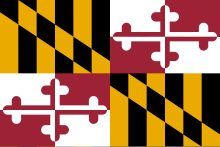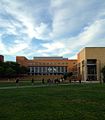Portal:Maryland
|
Maryland Portal
|
Baltimore Task Force
|
Frederick Task Force
|
Montgomery Task Force
|
WikiProject Maryland
|
|
Main page
|
Discussion
|
Introduction Maryland (US: /ˈmɛrɪlənd/ ⓘ MERR-il-ənd) is a state in the Mid-Atlantic region of the United States. It borders the states of Virginia to its south, West Virginia to its west, Pennsylvania to its north, Delaware and the Atlantic Ocean to its east, and the national capital and federal district of Washington, D.C. to the southwest. With a total area of 12,407 square miles (32,130 km2), Maryland is the ninth-smallest state by land area, and its population of 6,177,224 ranks it the 18th-most populous state and the fifth-most densely populated. Maryland's capital city is Annapolis, and the most populous city is Baltimore. Maryland's coastline was first explored by Europeans in the 16th century. Prior to that, it was inhabited by several Native American tribes, mostly the Algonquian peoples. As one of the original Thirteen Colonies, Maryland was founded by George Calvert, 1st Baron Baltimore, a Catholic convert who sought to provide a religious haven for Catholics persecuted in England. In 1632, Charles I of England granted Lord Baltimore a colonial charter, naming the colony after his wife, Henrietta Maria. In 1649, the Maryland General Assembly passed an Act Concerning Religion, which enshrined the principle of toleration. Religious strife was common in Maryland's early years, and Catholics remained a minority, albeit in greater numbers than in any other English colony. Maryland's early settlements and population centers clustered around waterways that empty into the Chesapeake Bay. Its economy was heavily plantation-based and centered mostly on the cultivation of tobacco. Demand for cheap labor from Maryland colonists led to the importation of numerous indentured servants and enslaved Africans. In 1760, Maryland's current boundaries took form following the settlement of a long-running border dispute with Pennsylvania. Many of its citizens played key political and military roles in the American Revolutionary War. Although it was a slave state, Maryland remained in the Union during the American Civil War, and its proximity to Washington D.C. and Virginia made it a significant strategic location. After the Civil War ended, Maryland took part in the Industrial Revolution, driven by its seaports, railroad networks, and mass immigration from Europe. Since the 1940s, the state's population has grown rapidly, to approximately six million residents, and it is among the most densely populated U.S. states. As of 2015[update], Maryland had the highest median household income of any state, owing in large part to its proximity to Washington, D.C., and a highly diversified economy spanning manufacturing, retail services, public administration, real estate, higher education, information technology, defense contracting, health care, and biotechnology. Maryland is one of the most multicultural states in the country; it is one of the six states where non-Whites compose a majority of the population, with the fifth-highest percentage of African Americans, and high numbers of residents born in Africa, Asia, Central America, and the Caribbean. The state's central role in U.S. history is reflected by its hosting of some of the highest numbers of historic landmarks per capita. (Full article...) This is a Featured article, which represents some of the best content on English Wikipedia..
William Matthews (December 16, 1770 – April 30, 1854), occasionally spelled Mathews, was an American who became the fifth Roman Catholic priest ordained in the United States and the first such person born in British America. Born in the colonial Province of Maryland, he was briefly a novice in the Society of Jesus. After being ordained, he became influential in establishing Catholic parochial and educational institutions in Washington, D.C. He was the second pastor of St. Patrick's Church, serving for most of his life. He served as the sixth president of Georgetown College, later known as Georgetown University. Matthews acted as president of the Washington Catholic Seminary, which became Gonzaga College High School, and oversaw the continuity of the school during suppression by the church and financial insecurity. Matthews was vicar apostolic and apostolic administrator of the Diocese of Philadelphia during a period of ecclesiastical turmoil. He was a co-founder and president of the Washington Library Company for thirteen years—the first public library in the District of Columbia. He also was co-director and trustee of the District of Columbia Public Schools, where he was one of the superintendents of a school. He played a significant role in the founding of Washington Visitation Academy for girls, St. Peter's Church on Capitol Hill, and the parish that now includes the Cathedral of St. Matthew the Apostle. Matthews was involved in Catholic charitable organizations as well; he was the founder and president of St. Vincent's Female Orphan Asylum and the co-founder and president of St. Joseph's Male Orphan Asylum. (Full article...) General imagesIn the news
On this day...This is a Good article, an article that meets a core set of high editorial standards.
 The Maryland Terrapins football team represents the University of Maryland, College Park in the sport of American football. The Terrapins compete in the NCAA Division I Football Bowl Subdivision (FBS) and the Big Ten Conference. The Terrapins joined the Big Ten Conference on July 1, 2014, following 62 years in the Atlantic Coast Conference as a founding member. Mike Locksley is the head coach of the Terrapins. Since 1950, the Terrapins have played their home games at SECU Stadium in College Park, Maryland, with occasional home games from time to time in Baltimore, making them one of two FBS football teams in the Baltimore–Washington metropolitan area (Navy Midshipmen) and the closest Football Bowl Subdivision team to Washington, D.C. The team's official colors of red, white, black, and gold have been in use in some combination since the 1920s and are taken from Maryland's state flag, and the Terrapins nickname — often abbreviated as "Terps" — was adopted in 1933 after the diamondback terrapin, a turtle species native to the state. Maryland shares storied rivalries with Virginia and West Virginia. (Full article...) Selected article -Jarvis U.S. General Hospital was a military hospital founded in Baltimore, Maryland, in 1861, at the beginning of the American Civil War, for the care of wounded Federal soldiers. The hospital was built on the grounds of Maryland Square, the former residence of the Steuart family, which had been confiscated by the Federal government at the outbreak of war. The hospital closed at the end of the war. (Full article...) Did you know?

SubcategoriesSelect [+] to view subcategories
TopicsRelated portalsAssociated WikimediaThe following Wikimedia Foundation sister projects provide more on this subject:
Discover Wikipedia using portals |























































